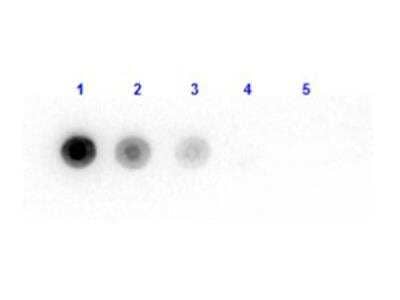Luciferase Antibody
Novus Biologicals, part of Bio-Techne | Catalog # NBP2-44165

Key Product Details
Species Reactivity
Bacteria
Applications
Dot Blot, ELISA, Immunohistochemistry, Immunoprecipitation, Western Blot
Label
Unconjugated
Antibody Source
Polyclonal Rabbit Serum
Concentration
Please see the vial label for concentration. If unlisted please contact technical services.
Product Specifications
Immunogen
Luciferase [Photobacterium fischerii] (Uniprot: P19907)
Reactivity Notes
Aliivibrio fischeri (Vibrio) Photobacterium
Cross reactivity against Luciferase from other tissues and species may occur but have not been specifically determined
Cross reactivity against Luciferase from other tissues and species may occur but have not been specifically determined
Clonality
Polyclonal
Host
Rabbit
Isotype
Serum
Description
This product was prepared from monospecific antiserum by a delipidation and defibrination. Assay by immunoelectrophoresis resulted in a single precipitin arc against anti-rabbit serum, purified and partially purified Luciferase [Photobacterium fischerii]
Store vial at 4C prior to restoration. For extended storage aliquot contents and freeze at -20C or below. Avoid cycles of freezing and thawing. Centrifuge product if not completely clear after standing at room temperature. This product is stable for several weeks at 4C as an undiluted liquid. Dilute only prior to immediate use.
Store vial at 4C prior to restoration. For extended storage aliquot contents and freeze at -20C or below. Avoid cycles of freezing and thawing. Centrifuge product if not completely clear after standing at room temperature. This product is stable for several weeks at 4C as an undiluted liquid. Dilute only prior to immediate use.
Scientific Data Images for Luciferase Antibody
Dot Blot: Luciferase Antibody [NBP2-44165] - Dot Blot results of Rabbit anti-Luciferase Antibody. Dots are Luciferase (Photobacterium fischerii) at (1) 100ng, (2) 33.3ng, (3) 11.1ng, (4) 3.70ng, (5) 1.23ng. Primary Antibody: Rabbit anti-Luciferase. Secondary Antibody: Goat Anti-Rabbit IgG HRP.
Applications for Luciferase Antibody
Application
Recommended Usage
ELISA
1:5000-1:25000
Immunohistochemistry
1:500-1:2500
Immunoprecipitation
1:100
Western Blot
1:1000-1:5000
Application Notes
This product has been tested by dot blot and is suitable for western blotting, immunohistochemistry, immunoprecipitation, and ELISA. Researchers should determine optimal titers for applications that are not stated below.
Formulation, Preparation, and Storage
Purification
Delipidation and Defibrination
Formulation
0.02 M Potassium Phosphate, 0.15 M Sodium Chloride, pH 7.2
Preservative
0.01% Sodium Azide
Concentration
Please see the vial label for concentration. If unlisted please contact technical services.
Shipping
The product is shipped with polar packs. Upon receipt, store it immediately at the temperature recommended below.
Stability & Storage
Store at -20C. Avoid freeze-thaw cycles.
Background: Luciferase
The luciferase assay is fast and sensitive, differentiating itself from the CAT (chloramphenicol acetyltransferase) assay because it does not require a radioactive substrate.
References
1. Eun, H. (1996). Marker/Reporter enzymes. Enzymology Primer for Recombinant DNA Technology, 567-645. doi:10.1016/b978-012243740-3/50011-9
2. McNabb, D. S., Reed, R., & Marciniak, R. A. (2005). Dual luciferase assay system for rapid assessment of gene expression in Saccharomyces cerevisiae. Eukaryotic Cell, 4(9), 1539-1549. doi:10.1128/ec.4.9.1539-1549.2005
3. Fraga, H. (2008). Firefly luminescence: A historical perspective and recent developments. Photochemical & Photobiological Sciences, 7(2), 146-158. doi:10.1039/b719181b
4. Younes, A., Lukyanenko, Y. O., Lyashkov, A. E., Lakatta, E. G., & Sollott, S. J. (2011). A bioluminescence method for direct measurement of phosphodiesterase activity. Analytical Biochemistry, 417(1), 36-40. doi:10.1016/j.ab.2011.05.036
Alternate Names
LuC, luciferin 4 monooxygenase, Luciferin 4-monooxygenase, Alkanal monooxygenase alpha chain, Alkanal monooxygenase beta chain, Bacterial luciferase alpha chain, Bacterial luciferase beta chain, luxA, luxB
UniProt
Additional Luciferase Products
Product Documents for Luciferase Antibody
Product Specific Notices for Luciferase Antibody
This product is for research use only and is not approved for use in humans or in clinical diagnosis. Primary Antibodies are guaranteed for 1 year from date of receipt.
